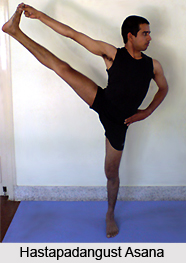 Hastapadangust Asana or the toe-finger-pose is a traditional Yoga pose, where variant poses may be divided into forward, backward and sideward movement.
Hastapadangust Asana or the toe-finger-pose is a traditional Yoga pose, where variant poses may be divided into forward, backward and sideward movement.
Practice of Hastapadangust Asana
* One should stand erect with legs straight, chest thrown forward, hands at the sides.
* While exhaling, one should slowly raise one leg (alternate use of the legs being implied) straight forward till it is brought at a right angle with the body.
* As far as possible, one should avoid bending either of the legs near the knee-joints. Balancing the body on one leg, one should stretch out the arms forward and either touch or take hold of the toes of the raised leg with the fingers of one or both hands, as convenient for the student.
* Then one has to try and retain this position for a few seconds in the beginning during the suspension of breath.
* One should inhale while returning to the starting position.
* This should be repeated thrice with each leg alternately in one minute. This exercise is best practiced in the morning.
* To retain harmony, the pace of breathing should be adjusted to the need of the physical movement.
* In Hastapadangust Asana, when the leg is raised sideward instead of forward, it forms a variant of the toe-finger pose. The other accessories of the movement remain the same as in the previous exercise.
* When Hastapadangust Asana is practiced by raising the leg alternately backward instead of forward or sideward, forms another variant of the toe-finger-pose.
Effects of Hastapadangust Asana
The flexion of the hip is followed by deep exhalation and increases the abdominal compression; there is simultaneous and proportionate rise in the intra-abdominal pressure. Further the slow alternate movements act as mild massage to the abdominal viscera by exercising those muscles and tendons of the lower abdomen and the hips which usually remain inactive otherwise. The Hastapadangust Asana thus affects abdominal tonicity favourably, and its value as a preventive measure in constipation and in reducing the waist-line may, therefore, be easily realized. The main muscles are exercised are hip flexors, abductors, extensors. Rectus femoris, sartorius, elbow extensors, wrist extensors and finger and thumb flexors are exercised. Hamstrings and gluteus maximus are stretched. Isometric contraction of the lower limb occurs in Hastapadangust Asana. It improves the range of movement of the hip and co-ordination of muscular activity.
Precautions in the practice of Hastapadangust Asana
For beginners, the mere alternate raising of the leg is indicated without the need for any effort to touch or hold the toes with the fingers. Three alternate rounds in each variety are enough, and the total time in all need not be more than three minutes.
It may be observed that, in the early stages of Hastapadangust Asana, if the finger cannot be made to touch the toes or if the knee of either leg bends slightly, one should try to rectify the error each day till the correct technique is acquired. During the initial attempts, if any strain is felt, one should place the hands on their respective hips, and practice only the leg movements.




















